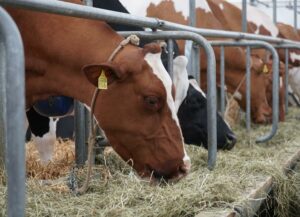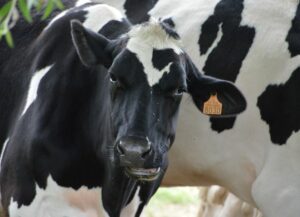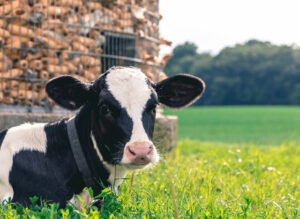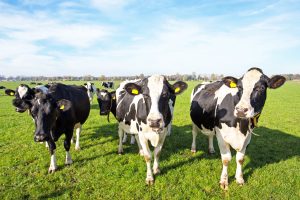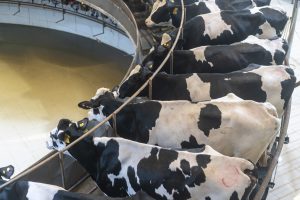Álvaro García
According to the US National Animal Health Monitoring System, ketosis ranks second only to hypocalcemia among the metabolic diseases detected by dairy farmers. It is of high concern because of its high incidence which has been reported at 40%, with a negative effect on cow health and productivity.
Ketosis in dairy cows
It is a common metabolic problem in adult cows which shows mostly in early lactation and is characterized by loss of appetite and depression. Additional signs are usually associated with the nervous system including abnormal behavior, abnormal licking, incoordination, and even aggression.
It is caused by the high glucose demands for milk production in early lactation, followed by mobilization of body fat reserves in early lactation. When body fat is mobilized non-esterified fatty acids (NEFA) increase in blood which during gluconeogenesis lead to the synthesis of the ketone bodies in the liver: acetone, acetoacetate, and β-hydroxybutyrate (BHB).
Types of ketosis
Two types of ketosis have been described:
- type I, which usually occurs during the peak of the lactation
- type II, which happens immediately post-calving (and usually associated with fatty liver)
At the present time little is known of its exact pathogenesis although it is suspected that metabolites of the ketone bodies mentioned before are likely responsible.
Excessive ketone body formation can result in hyperketonemia which is defined when blood BHB concentration equals or exceeds 1.2 mmol/L.
Ketosis treatments
Since prevention is not always practical or even effective, having treatment alternatives are always important for the dairy farmer. Considering its origin, most treatments have dealt with early stimulation of gluconeogenesis, improving blood glucose, and reducing NEFA in blood. As such the oral administration of propylene glycol (PG) has been popular as a successful therapy, but more recently other adjuvant treatments with dexamethasone, B12, and insulin have also been explored.
Treatment with PG together with L-carnitine and methionine has also shown promise, particularly with improving milk yield although no changes in health or reproduction have been observed when compared to PG alone.
More recently the combination of PG with intravenous administration of dextrose has shown promise by showing an improved short-term metabolic response resulting in an increase in blood insulin and a drop in BHB and NEFA.
An experiment (Capel et al., 2021) was conducted in four farms selected for this trial which had to meet the following criteria:
- have at least 1,000 cows in milk
- have headlocks in fresh cow pens
- use Dairy-Comp 305 farm as farm management software
- milk three times a day
Farm 1 milked 2,100 cows at 40 kg milk/day per cow; Farm 2 milked 1,000 cows at 40 kg milk/day per cow; Farm 3 milked 2,500 cows at 38 kg milk/day per cow; Farm 4 milked 1,550 cows at 40 kg milk/day per cow. All four farms dosed their cows with anionic salts and milked them 3 times a day.
Cows preliminary selected were those with no history of retained placenta, metritis, or hyperketonemia. Of these cows, those that tested for BHB under 1.2 mmol/L were preselected. They were then re-tested the following week, and those that had increased their BHB to ≥1.2 mmol/L were assigned to one of the three following treatments:
- 300 ml of oral PG once/d for 3 days (PG3)
- 300 ml of oral PG once/d for 3 days + 500 ml iv of 50% dextrose iv on day 1 (PG3D1)
- 300 ml of oral PG once/d for 3 days + 500 ml iv of 50% dextrose iv on all 3 days (PG3D3)
Effects of treatment with dextrose and propylene glycol
The results showed no effect of the treatments on the risk of resolving hyperketonemia post-treatment at week 1 or week 2 following the initial diagnosis.
Milk production was on average similar between treatment groups (PG3: 42.7 kg/day; PG3D1: 42.4 kg/day; PG3D3: 42.6 kg/day). Using dextrose in combination with PG showed no advantage for the treatment of hyperketonemia or even a reduction in any adverse events (i.e. sold, died, metritis, displaced abomasum, or ketosis) during the first 60 days of lactation.
Milk production was not different during the first 10 weeks of lactation.
Conclusion
This study suggests there are no health or production benefits to using dextrose together with PG when treating hyperketonemia. Furthermore, administration of dextrose intravenous requires additional labor, and it is not exempt from local inflammatory processes when not done right.
The authors concluded that drenching with propylene glycol continues to be the most effective therapy to treat cows at risk of developing ketosis.
Reference
M.B. Capel, K.D. Bach, S. Mann, J.A.A. McArt. A randomized controlled trial to evaluate propylene glycol alone or in combination with dextrose as a treatment for hyperketonemia in dairy cows. Journal of Dairy Science, Volume 104, Issue 2, 2021, Pages 2185-2194, ISSN 0022-0302, https://doi.org/10.3168/jds.2020-19111.
© 2021 Dellait Dairy Knowledge Center. All Rights Reserved.




